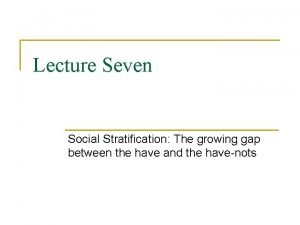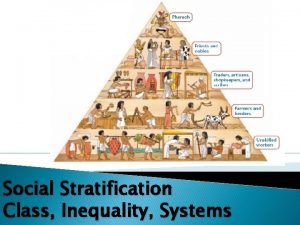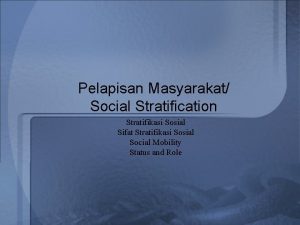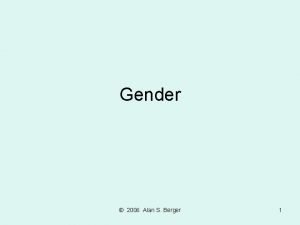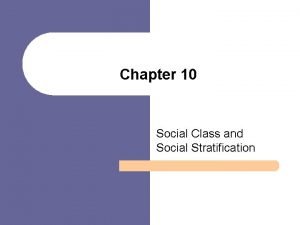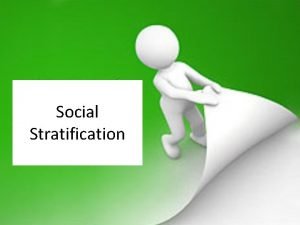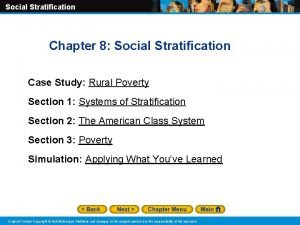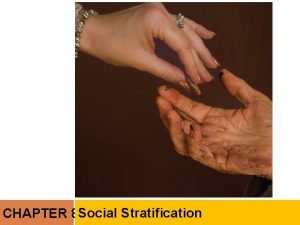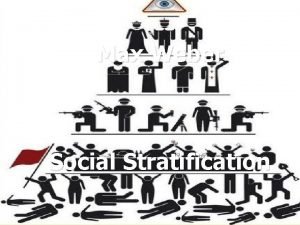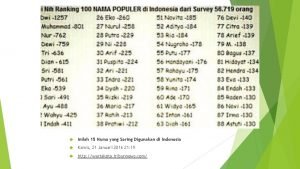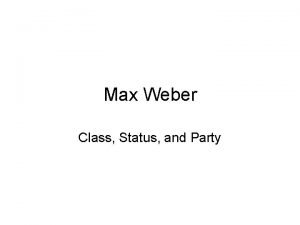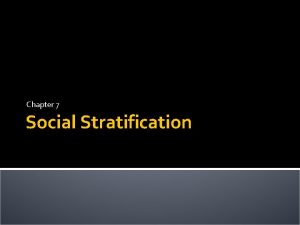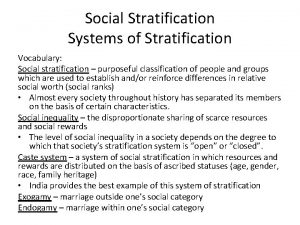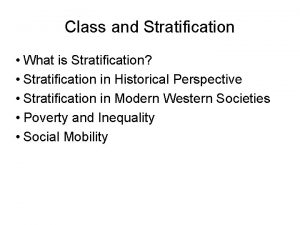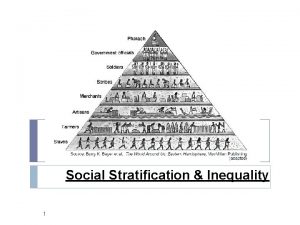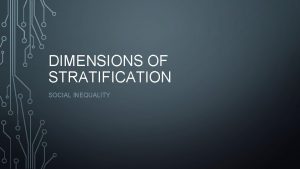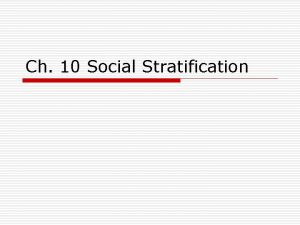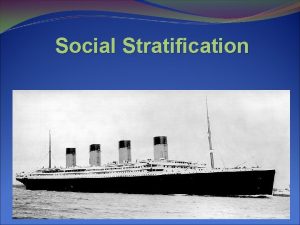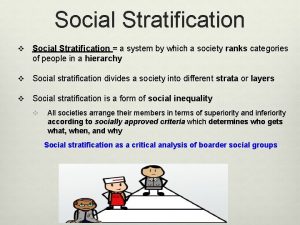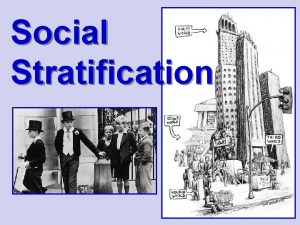7 Social Stratification What Divides Us Stratification Social

















- Slides: 17

7. Social Stratification

What Divides Us: Stratification • Social stratification refers to the unequal distribution around the world of the three Ps: property, power, and prestige.

Property Karl Marx assigned industrial society two major and one minor classifications: • The bourgeoisie (capitalist class), they are those who own the methods of production and employ others to work for them. • Petite bourgeoisie (small capitalist class), are those who own the means of production but do not employ others. These include self-employed persons, like doctors, lawyers, and tradesmen. • Proletariat (worker class). are those who do not own the means of production, do not hire others, and thus are forced to work for the capitalists.

• In order to survive, workers are going to work long, hard hours under less-than-ideal circumstances to maximize the profits of the capitalists. Marx also held that given enough discontent with their exploitation, workers would subsequently organize to revolt against their “employers” to form a “classless” society of economic equals.

Power • The capacity to influence people and events to obtain wealth and prestige. • Being rich, as evidenced by the domination of wealthy males in high-ranking governmental positions. • Wealthier are also more likely to be politically active as way of ensuring their continued power and wealth. In contrast, poorer. • These power elite hold key positions in the highest branches of the government, military, and business world.

• Elite theorists argue that a few hundred individuals hold all of the power in the world. • Conflict theorists hold that only a small number of the capitalists hold the vast majority of power in the heir countries. • Pluralist theorists hold that power is not in the hands of the elite or a few, but rather it is widely distributed among assorted competing and diverse groups.

Prestige • An individual's status among his or her peers in society. • Occupation and education are means for social prestige.

Types of Social Classes of People Social class refers to a group of people with similar levels of wealth, influence, and status. Sociologists typically use three methods to determine social class: 1. The objective method measures and analyzes “hard” facts. 2. The subjective method asks people what they think of themselves. 3. The reputational method asks what people think of others

• The lower class is typified by poverty, homelessness, and unemployment. People of this class, few of whom have finished high school, suffer from lack of medical care, adequate housing and food, decent clothing, safety, and vocational training.

• The working class Those minimally educated people who engage in “manual labor” with little or no prestige. Unskilled workers in the class—dishwashers, maids, and waitresses—usually are underpaid and have no opportunity for career advancement. They are often called the working poor. Skilled workers in this class—carpenters, plumbers, and electricians—are often called blue collar workers. They make more money than workers in the middle class their jobs are usually more 3 Ds.

• The middle class are the “sandwich” class. These white collar workers have more money than those below them on the “social ladder, ” but less than those above them. They are divided into two levels according to wealth, education, and prestige: 1. The lower middle class is often made up of less educated people with lower incomes, such as managers, small business owners, and teachers. 2. The upper middle class is often made up of highly educated business and professional people with high incomes, such as doctors, and lawyers.

• The upper class This class is divided into two groups: 1. Lower-upper: those with “new money, ” or money made from investments, business ventures, and so forth. 2. Upper-upper: includes those aristocratic and “high-society” families with “old money” who have been rich for generations. The upper-upper class is more prestigious than the lower-upper class.

Social Mobility Is it possible for people to move within a society's stratification system? Yes, but the degree to which this is possible varies considerably from society to society. 1. Social position in a caste system is decided by assignment rather than attainment. This means people are either born into or marry within their family's caste; changing caste systems is very rare. 2. In an open society with a class system, mobility is possible. The positions in this stratification system depend more on achieved status, like education, than on ascribed status, like gender.

• Patterns of social mobility Several patterns of social mobility are possible: Horizontal mobility involves moving within the same status category. Vertical mobility, upward mobility and downward mobility. Intragenerational mobility, also termed career mobility, refers to a change in an individual's social standing, especially in the workforce. Intergenerational mobility refers to a change in social standing across generations, such as occurs when a person from a lower-class family graduates from medical school.

• Structural mobility and individual mobility • Major upheavals and changes in society can enhance large numbers of people's opportunities to move up the social ladder at the same time. This form of mobility is termed structural mobility. • Individual characteristics—such as race, ethnicity, gender, religion, level of education, occupation, place of residence, health, and so on—determine individual mobility.

Causes and Effects of Poverty Many perspectives to explain the causes of poverty: • Some theorists have accused the poor of their poverty, • Others have accused them of engaging in selfdefeating behavior, • Other theorists have characterized the poor as fatalists, resigning themselves to a culture of poverty. • Minimum wages and lack of access to the education, • According to another theory, the poor would rather receive welfare payments than work

The effects of poverty • The effects of poverty are serious. Children who grow up in poverty suffer more persistent, frequent, and severe health problems than do children who grow up under better financial circumstances. • Levels of stress in the family have also been shown to correlate with economic circumstances. • Families are more likely to be exposed to series of negative events and “bad luck, ” including illness, depression, eviction, job loss, criminal victimization, and family death.
 Social stratification vs social inequality
Social stratification vs social inequality Social stratification
Social stratification Mixed social stratification
Mixed social stratification Gender stratified
Gender stratified Social stratification slideshare
Social stratification slideshare Max weber social classes
Max weber social classes Social inequalities examples
Social inequalities examples Chapter 8 social stratification
Chapter 8 social stratification American class system
American class system Max weber social stratification
Max weber social stratification Marx social stratification
Marx social stratification Systems of social stratification
Systems of social stratification Social stratification in sociology
Social stratification in sociology Jelaskan pengertian stratifikasi sosial ! *
Jelaskan pengertian stratifikasi sosial ! * Mixed social stratification
Mixed social stratification Chapter 9 social stratification
Chapter 9 social stratification Causes of social mobility
Causes of social mobility Class, status, party weber summary
Class, status, party weber summary
